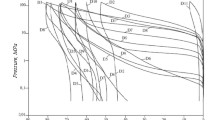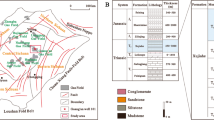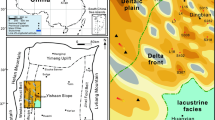Abstract
Pore structure, which not only determines the microscopic characteristics of reservoirs but also controls the macroscopic physical properties of reservoirs, has been difficult to study in reservoir research. Fractal theory is an effective method for quantitative analysis of the irregular and complex pore structures of rocks. On the basis of high-pressure mercury intrusion experiments, the fractal dimensions of tight sandstones in the Yanchang Formation of the Triassic in the Ordos Basin are calculated by two methods (the water saturation method and mercury saturation method), and the fractal characteristics of the pore structures in this tight sandstone reservoir are also analyzed. The results show that the pore structures of tight sandstone reservoirs are heterogeneous and can be divided into four types. The fractal dimensions calculated by the water saturation method are poorly correlated with reservoir quality, while the fractal dimensions calculated by the mercury saturation method have good correlation with reservoir quality, that is, reservoirs with low fractal dimensions have high reservoir permeability and large pore-throat radii, while reservoirs with high fractal dimensions have low reservoir permeability and small pore-throat radii. Therefore, the fractal dimensions calculated by the mercury saturation method are presented to characterize tight sandstone reservoirs. The pore structures with large pore-throat sizes (radius>rtr) and small pore-throat sizes (radius<rtr) are relatively independent, and this results in clear turning points on the fractal curves of most samples. More importantly, samples with different fractal characteristics can represent reservoirs with different physical properties and pore structures. In conclusion, fractal dimensions can be used as an effective parameter for the quantitative characterization of tight sandstone reservoir with ultra-low permeability.











Similar content being viewed by others
References
Avnir D, Farin D, Pfeifer P (1984) Molecular fractal surfaces. Nature 308(5956):261–263
Bustin RM, Bustin AMM, Cui A, Ross D, Pathi M (2008) Impact of Shale Properties on Pore Structure and Storage Characteristics. SPE. https://doi.org/10.2118/119892-MS
Camp WK (2011) Pore-throat sizes in sandstones, tight sandstones, and shales: Discussion. AAPG Bull 95:1443–1144
Cao L, Sun W, Sheng J, Huo L, Chen Q, Xie C (2016) A method to determine movable fluids saturation of low-permeability and tight oil reservoirs-by taking tight oil reservoirs in sixth member of Yanchang formation in banqiao area as an example. J South Yangtze Univ (Natural Science Edition) 13(20):1–8
Chen C, Sun YM (1996) Fractional dimension of the pore-texture in sandstones and its application. Acta Sedimentol Sin 14(4):108–113
Friesen WI, Mikula RJ (1987) Fractal dimensions of coal particles. J Colloid Interface Sci 120(87):263–271
Gao H, Xie W, Yang JP, Zhang C, Sun W (2011) Pore throat characteristics of extra-ultralow permeability sandstone reservoir based on constant-rate mercury penetration technique. Pet Geol Exp 33(206-211):214
Gao H, Yu B, Duan Y, Fang Q (2014) Fractal analysis of dimensionless capillary pressure function. Int J Heat Mass Transf 69:26–33
Giri A, Tarafdar S, Gouze P, Dutta T (2012) Fractal pore structure of sedimentary rocks: simulation in 2-D using a relaxed bidisperse ballistic deposition model. J Appl Geophys 87:40–45
He CZ, Hua MQ (1998) Fractal geometry description of reservoir pore structure. Oil Gas Geol 19(1):17–23
Hu Q, Ewing RP, Dultz S (2012) Low pore connectivity in natural rock. J Contam Hydrol 133:76–83
Ji W, Song Y, Jiang Z, Meng M, Liu Q, Chen L, Wang P, Gao F, Huang H (2016) Fractal characteristics of nano-pores in the Lower Silurian Longmaxi shales from the Upper Yangtze Platform, south China. Mar Pet Geol 78:88–98
Jouini MS, Vega S, Mokhtar EA (2011) Multiscale characterization of pore spaces using multifractals analysis of scanning electronic microscopy images of carbonates. Nonlinear Process. Geophys. 18(6):941–953
Katz AJ, Thompson AH (1985) Fractal sandstone pores: implications for conductivity and pore formation. Phys Rev Lett 54(12):1325–1328
Krohn CE (1988) Fractal measurements of sandstones, shales, and carbonates. J Geophys Res Solid Earth 93(B4):3297–3305
Kulesza S, Bramowicz M (2014) A comparative study of correlation methods for determination of fractal parameters in surface characterization. Appl Surf Sci 293:196–201
Lai J, Wang GW (2015) Fractal analysis of tight gas sandstones using high-pressure mercury intrusion techniques. J Nat Gas Sci Eng 24:185–196
Li K (2010) Analytical derivation of Brooks-Corey type capillary pressure models using fractal geometry and evaluation of rock heterogeneity. J Pet Sci Eng 73:20–26
Li K, Horne RN (2004) Universal capillary pressure and relative permeability model from fractal characterization of rock. In: Th Stanford Geothermal Workshop on Geothermal Reservoir Engineering. Stanford University, Stanford, California
Li P, Sun W, Wu BL, Gao YL, Du K (2018a) Occurrence characteristics and influential factors of movable fluids in pores with different structures of Chang 63 reservoir, Huaqing Oilfield, Ordos Basin, China. Mar Pet Geol. 97:480–492
Li Z, Wu SH, Xia DL, He SC, Zhang XF (2018b) An investigation into pore structure and petrophysical property in tight sandstones: A case of the Yanchang Formation in the southern Ordos Basin, China. Mar Pet Geol 97:390–406
Liu Z, Zhu X, Liao J (2013) Sequence stratigraphy and genesis of sand bodies of the upper Triassic Yanchang formation in the southwestern margin of Ordos Basin. Earth Sci Front 20(2):001–009
Mandelbrot BB (1977) Fractals: Form, Chance, and Dimensions. W. H, Freeman and Company, San Francisco
Mandelbrot BB, Wheeler JA (1983) The fractal geometry of nature. Q Rev Biol 147:468
National Development and Reform Commission, China (NDRCC) (2005) SY/T5346-2005: Rock Capillary Pressure Measurement.
National Development and Reform Commission, China (NDRCC) (2006) SY/T5336-2006: Practices for core analysis.
Pfeifer P, Avnir D (1983) Chemistry nonintegral dimensions between two and three. J Chem Phys 79(7):3369–3558
Ross DJK, Bustin RM (2009) The importance of shale composition and pore structure upon gas storage potential of shale gas reservoirs. Mar Pet Geol 26:916–927
Thompson AH, Katz AJ, Krohn CE (1987) The micro-geometry and transport properties of sedimentary rock. Adv Phys 36(5):625–694
Wang HW, Anovitz LM, Burg A, Cole DR, Allard LF, Jackson AJ, Stacka AG, Rothera G (2013) Multi-scale characterization of pore evolution in a combustion metamorphic complex, Hatrurim basin, Israel: combining (ultra) small-angle neutron scattering and image analysis. Geochim Cosmochim Acta 121:339–362
Wang M, Xue H, Tian S, Wilkins RWT, Wang Z (2015) Fractal characteristics of Upper Cretaceous lacustrine shale from the Songliao Basin, NE China. Mar Pet Geol 67:144–153
Wu H, Guo YH, Zhang CL, Liu RE (2013) Characteristics and classifications of pore structure in tight oil reservoir: A case study of the Triassic Yanchang formation Chang7 in Longdong area, Ordos basin. J Northeast Pet Univ 37:12–17
Xie S, Cheng Q, Ling Q, Li B, Bao Z, Fan P (2010) Fractal and multifractal analysis of carbonate pore-scale digital images of petroleum reservoirs. Mar Pet Geol 27:476–485
Yang YT, Li W, Ma L (2005) Tectonic and stratigraphic controls of hydrocarbon systems in the Ordos basin: a multicycle cratonic basin in central China. AAPG Bull 89:255–269
Yang H, Dou WT, Liu XY, Zhang CL (2010) Analysis on sedimentary facies of Member 7 in Yanchang Formation of Triassic in Ordos Basin. Acta Sedimentol Sin 28(2):254–263
Yang H, Li SX, Liu XY (2013) Characteristics and resource prospects of tight oil and shale oil and shale oil in Ordos Basin. Acta Pet Sin 34:1–11
Zheng RC, Wang CY, Li H, Lei GM, Xie CH (2007) Provenance analysis of Chang 6 oil-bearing formation of Baibao-Huachi region in Ordos Basin. Lithologic Reservoirs 01:32–38
Zhou Y, Ji YL, Xu LM, Che SQ, Niu XB, Wan L, Zhou YQ, Li ZC, You Y (2016) Controls on reservoir heterogeneity of tight sand oil reservoirs in Upper Triassic Yanchang Formation in Longdong Area, southwest Ordos Basin, China: Implications for reservoir quality prediction and oil accumulation. Mar Pet Geol 78:110–135
Zhu RK, Wu ST, Su L, Cui JW, Mao ZG, Zhang XX (2016) Problems and future works of porous texture characterization of tight reservoirs in China. Acta Pet Sin 37:1323–1336
Zhu YX, Sun W, Yu F (2008) Application of high-pressure Hg injection and rate-controlled Hg penetration experimental technique to studying reservoir microscopic pore structure: Taking Toutunhe Formation in Niuquanhu area of Santanghu oil-field as an example. Nat Gas Geosci 19:553–556
Zou CN, Zhu RK, Liu KY, Su L, Bai B, Zhang XX, Yuan XJ, Wang JH (2012) Tight gas sandstone reservoirs in China: characteristics and recognition criteria. J Pet Sci Eng 88-89:82–91
Acknowledgments
The authors would like to thank PetroChina Changqing Oilfield Company for providing samples and data access.
Funding
This study was financially supported by the National Major Science and Technology Projects of China (No. 2017ZX05009001 and No. 2017ZX05013-004-002).
Author information
Authors and Affiliations
Corresponding author
Additional information
Responsible Editor: Santanu Banerjee
Rights and permissions
About this article
Cite this article
Wang, J., Wu, S., Li, Q. et al. An investigation into pore structure fractal characteristics in tight oil reservoirs: a case study of the Triassic tight sandstone with ultra-low permeability in the Ordos Basin, China. Arab J Geosci 13, 961 (2020). https://doi.org/10.1007/s12517-020-05928-0
Received:
Accepted:
Published:
DOI: https://doi.org/10.1007/s12517-020-05928-0




